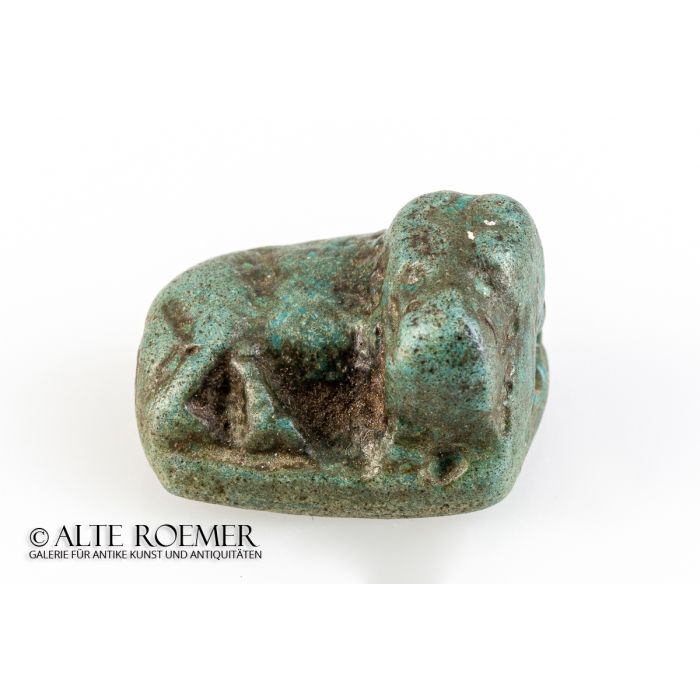Egyptian hippopotamus amulet
Price: on request
Sold
Object number
AR2499-11
| Object: |
Egyptian amulet in the shape of a hippopotamus
|
| Material: |
Turquoise faience.
|
| Period: |
18th to 19th dynasty of Ancient Egypt. 1550 BC to 1186 BC. New Kingdom. |
| Description: |
Egyptian amulet inspired by the scarabs but in the shape of a lying hippopotamus on the upper side. The bottom side is flat. A longitudinal drillhole allowed wearing the piece as an amulet.
|
| Background: |
In ancient Egypt, the hippopotamus was an animal closely interwoven with the world of the gods. The goddess Taweret, the patron goddess of pregnant women, usually appeared in the shape of a hippopotamus. The wearer of this hippo amulet must also have expected a magical protective effect. In the time of the pharaoh Thutmose III, hippopotamus amulets became very popular. He ruled in the mid-15th century BC, the 18th dynasty of Ancient Egypt. The popularity continued until the Ramesside period, i.e. until the 19th dynasty, when other animal amulets took away the hippopotamus' market leadership. These dates mark the period of origin of the present specimen. |
| Dimensions: |
18mm length, 13mm width, 11mm height.
|
| Condition: |
Perfect condition. With modern leather string and brass lock (no seen on the photos). It can be worn as a good luck charm around the neck.
|
| Provenance: |
Acquired by us in a German auction house in 2018. Consigned by the heir of a German private collection. Acquired for the collection in May 1980 from the stock of the "Aegyptiaca" society in Switzerland. Selected and brokered by Hermann Schlögl (Freiburg i. Br.). The Aegyptiaca society sold this object from the famous Matouk collection which was in storage at the archaeological collection of Zürich university. It was brought there in 1976, exported from Lebanon, with no Lebanese laws prohibiting the export. The piece was published in Matouk's 1971 book and was in Beirut at that time. Fouad S. Matouk formed his collection between 1925 and 1976. It was located in Egypt until 1960 and in Lebanon afterwards. About the famous Matouk collection: The collection of Fouad Sélim Matouk (1902-1978) included 8520 ancient Egyptian seals, amulets and bronzes, as well as some pieces dating to Greco-Roman and Coptic times. The collection held 6800 scarabs, the third biggest amount worldwide after the Egyptian Museum in Cairo and the British Museum in London. Being Christian Arabs Matouk's parents with his son fled their country of birth Syria and settled in Egypt at the beginning of the 20th century. It was there young Matouk started to build his collection in the mid 1920ies. A prominent part was acquired by him in 1956 in Cairo. It came from the also famous collection of the antiquities dealer Ralph Harrup Blanchard (1875-1936). As a whole the Matouk collection was based on a scientific point of view concerning the typological evolution of form and decoration. In the year 1960 the collector and trader had to leave Egypt under Nassar's rule and flea to Lebanon. After the Lebanese civil war started Matouk brought his collection to safety in Switzerland in 1976. That is how it could be protected from the chaos of the war, except for the ancient glasses which fell prey to the war. Shortly afterwards financial pressure made Matouk decide to sell his collection. He wanted the archaeological institute of Zürich university to have it. But after his unexpected death in 1978 in Beirut his son Tawfik Fouad Matouk had to continue this endeveaor. Zürich university could not pay the full price. The resulting idea was the foundation of the "Aegyptiaca" society with the financial aid of the Swiss Federation. The society should sell part of the Matouk collection to private collectors until the revenue was enough to buy the remaining part of the collection for Zürich University. Before that the objects were properly researched by the renowned archeologists Prof. Dr. Eric Hornung, Prof. Dr. Othmar Keel, Dr. Leo Mildenberg, Dr. Hermann Schlögl and Dr. Michael Sguaitamatti. In the end the largest part of the objects were added to the stock of Fribourg University. There, Othmar Keel worked with the pieces, in his function as a Professor for Old Testament and Biblical Environment. From the part sold to collectors initially a significant amount of objects could be acquired by Alte Roemer Gallery in 2018 and 2019. We are extremely happy to be able to work with those important pieces ourselves. The younger history including names like Matouk and Blanchard is proudly standing up to the Old Egyptian history of those little works of art. |
| Publication: |
This piece is shown in F. S. Matouk, Corpus du scarabée égyptien. Vol. II: Analyse thématique (Beyrouth, 1971). P. 110 und 386, no. 685.
|
| References: |
Cf. P. E. Newberry, Egyptian Scarabs, p. 87, no. 89. Cf. C. Andrews, Amulets of Ancient Egypt, p. 53, no. 54j. |
| Literature: |
Literature in respect to the Matouk collection: F. S. Matouk, Corpus du scarabée égyptien, Vol. I: Les scarabées royaux (Beyrouth, 1971). The catalogue includes 904 objects of the collection. F. S. Matouk, Corpus du scarabée égyptien. Vol. II: Analyse thématique (Beyrouth, 1971). The catalogue includes 2480 objects of the collection. O. Keel und C. Uehlinger, Altorientalische Miniaturkunst. The only published work about pieces from the Blanchard collection: R. H. Blanchard, Handbook of Egyptian Gods and Mummy Amulets (1909). |
| Authenticity: |
We unconditionally guarantee the authenticity of every artefact, all items are subject to our lifetime return policy on authenticity.
|


